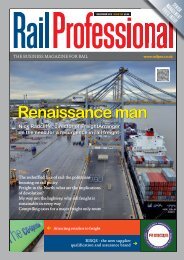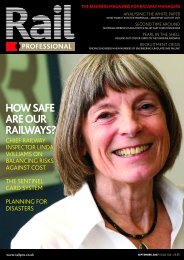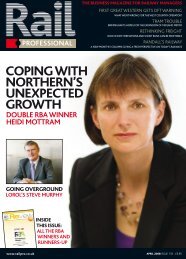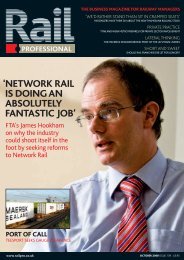View as PDF - Rail Professional
View as PDF - Rail Professional
View as PDF - Rail Professional
Create successful ePaper yourself
Turn your PDF publications into a flip-book with our unique Google optimized e-Paper software.
Comment<br />
Putting your best<br />
foot forward<br />
Trackside workers can spend most of their shift on their<br />
feet, in all weathers. Yvette Ashby, managing director<br />
of the Workwear and Corporate Clothing Show, looks at<br />
the footwear requirements for lineside staff<br />
As plans progress for<br />
Crossrail and HS2, there<br />
will undoubtedly be a<br />
significant incre<strong>as</strong>e in<br />
demand for technical<br />
rail workers, including<br />
track and signalling engineers, <strong>as</strong> well <strong>as</strong><br />
overhead electrification specialists. And with<br />
this expansion in the workforce, there will<br />
be a corresponding incre<strong>as</strong>e in demand for<br />
safety workwear and personal protective<br />
equipment (PPE).<br />
In the rail industry, the safety of rail<br />
workers is paramount at all times and it is<br />
vital that employers ensure staff are kitted<br />
out in line with health and safety regulations<br />
in mandatory, fit-for-purpose safety clothing,<br />
PPE and safety footwear.<br />
In terms of safety footwear, the need for<br />
functional, robust and comfortable boots is<br />
important. Luckily, there h<strong>as</strong> never been so<br />
much choice in the market <strong>as</strong> there is today.<br />
While this is good news for the workforce,<br />
it can be well nigh impossible for a health<br />
and safety or procurement manager to know<br />
where to start.<br />
A comprehensive risk <strong>as</strong>sessment will<br />
dictate the specific safety requirements of<br />
footwear by identifying the potential hazards<br />
that the wearer needs to be protected from<br />
in their working environment. In the rail<br />
industry, these vary from electrical hazards<br />
and uneven and slippery surfaces to falling<br />
objects, including heavy machinery and the<br />
presence of oil, chemicals and sharp objects.<br />
It is also important to take into<br />
consideration the fact that track-side<br />
workers will be exposed to all the elements<br />
and must be protected from inclement<br />
weather. If workers’ cold feet contribute to<br />
a reduction in core body temperature, this<br />
can lead to them not only feeling the cold<br />
but losing concentration and motivation.<br />
Ultimately, their productivity falls.<br />
Unlike clothing, which can be e<strong>as</strong>ily<br />
added or removed <strong>as</strong> and when needed, safety<br />
footwear is worn throughout a shift or an<br />
entire day. It is therefore essential that safety<br />
boots are breathable.<br />
Trackside staff can cover a great deal of<br />
ground, spending most of a shift walking<br />
non-stop for several miles while inspecting<br />
or repairing track, so comfort is a necessity<br />
for long periods of use.<br />
Above all, safety footwear for rail<br />
professionals should be selected to fit the<br />
specification for the environment where it<br />
will be worn. Generally for track-side staff<br />
and technical engineers this means safety<br />
boots that are robust, provide good ankle<br />
protection and support, have a hard wearing<br />
sole, tough tread, steel toe-cap/steel mid sole,<br />
comply with BS EN ISO20345 and provide<br />
wearer comfort and waterproof protection.<br />
This sounds like a tall order but help<br />
is at hand from safety workwear and PPE<br />
manufacturers and suppliers that have years<br />
of experience providing rail networks with<br />
the workwear and safety footwear they need<br />
to keep their workforce protected.<br />
The days of ‘one-shoe-fits-all’ are long<br />
gone when it comes to safety footwear.<br />
There are many more decisions to be made<br />
when procuring footwear and it is vital to<br />
ensure that safety boots and shoes are not<br />
only durable, fit for purpose and conform<br />
with EN standards, but are also comfortable<br />
and a good fit.<br />
n The Workwear and Corporate Clothing<br />
Show (www.workwearshow.com) takes<br />
place from 17-18 April at the Ricoh<br />
Arena in Coventry. It is a major event<br />
in the professional clothing industry’s<br />
calendar and will showc<strong>as</strong>e the best and<br />
most innovative suppliers of workwear,<br />
corporate clothing and personal protective<br />
equipment in the industry<br />
MARCH 2012 Page 23
















